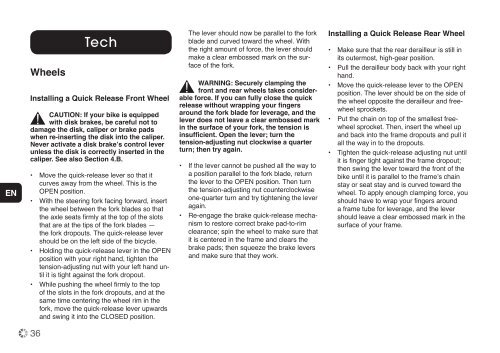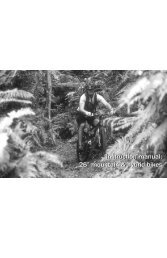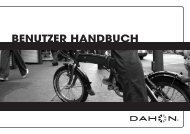BRUKERVEILEDNING - Dahon
BRUKERVEILEDNING - Dahon
BRUKERVEILEDNING - Dahon
Create successful ePaper yourself
Turn your PDF publications into a flip-book with our unique Google optimized e-Paper software.
EN<br />
Wheels<br />
Installing a Quick Release Front Wheel<br />
CAUTION: If your bike is equipped<br />
with disk brakes, be careful not to<br />
damage the disk, caliper or brake pads<br />
when re-inserting the disk into the caliper.<br />
Never activate a disk brake’s control lever<br />
unless the disk is correctly inserted in the<br />
caliper. See also Section 4.B.<br />
• Move the quick-release lever so that it<br />
curves away from the wheel. This is the<br />
OPEN position.<br />
• With the steering fork facing forward, insert<br />
the wheel between the fork blades so that<br />
the axle seats firmly at the top of the slots<br />
that are at the tips of the fork blades —<br />
the fork dropouts. The quick-release lever<br />
should be on the left side of the bicycle.<br />
• Holding the quick-release lever in the OPEN<br />
position with your right hand, tighten the<br />
tension-adjusting nut with your left hand until<br />
it is tight against the fork dropout.<br />
• While pushing the wheel firmly to the top<br />
of the slots in the fork dropouts, and at the<br />
same time centering the wheel rim in the<br />
fork, move the quick-release lever upwards<br />
and swing it into the CLOSED position.<br />
36<br />
Tech<br />
The lever should now be parallel to the fork<br />
blade and curved toward the wheel. With<br />
the right amount of force, the lever should<br />
make a clear embossed mark on the surface<br />
of the fork.<br />
WARNING: Securely clamping the<br />
front and rear wheels takes considerable<br />
force. If you can fully close the quick<br />
release without wrapping your fingers<br />
around the fork blade for leverage, and the<br />
lever does not leave a clear embossed mark<br />
in the surface of your fork, the tension is<br />
insufficient. Open the lever; turn the<br />
tension-adjusting nut clockwise a quarter<br />
turn; then try again.<br />
• If the lever cannot be pushed all the way to<br />
a position parallel to the fork blade, return<br />
the lever to the OPEN position. Then turn<br />
the tension-adjusting nut counterclockwise<br />
one-quarter turn and try tightening the lever<br />
again.<br />
• Re-engage the brake quick-release mechanism<br />
to restore correct brake pad-to-rim<br />
clearance; spin the wheel to make sure that<br />
it is centered in the frame and clears the<br />
brake pads; then squeeze the brake levers<br />
and make sure that they work.<br />
Installing a Quick Release Rear Wheel<br />
• Make sure that the rear derailleur is still in<br />
its outermost, high-gear position.<br />
• Pull the derailleur body back with your right<br />
hand.<br />
• Move the quick-release lever to the OPEN<br />
position. The lever should be on the side of<br />
the wheel opposite the derailleur and freewheel<br />
sprockets.<br />
• Put the chain on top of the smallest freewheel<br />
sprocket. Then, insert the wheel up<br />
and back into the frame dropouts and pull it<br />
all the way in to the dropouts.<br />
• Tighten the quick-release adjusting nut until<br />
it is finger tight against the frame dropout;<br />
then swing the lever toward the front of the<br />
bike until it is parallel to the frame’s chain<br />
stay or seat stay and is curved toward the<br />
wheel. To apply enough clamping force, you<br />
should have to wrap your fingers around<br />
a frame tube for leverage, and the lever<br />
should leave a clear embossed mark in the<br />
surface of your frame.





